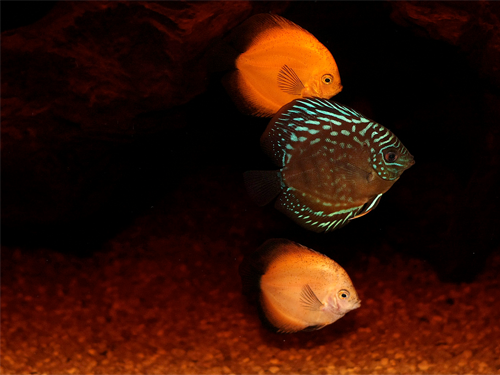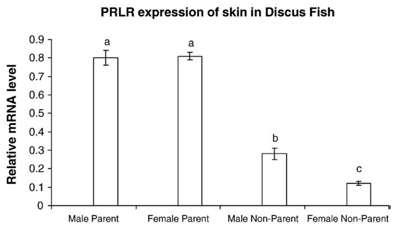So why this preface in defense of fish? I have found a little story that more than anything I've read lately highlights the deep connection between fish and mammals and does a very good job at blurring the distinction between what's considered typically mammal and what fish are capable of. Plus, it relates to my own research.

Discus fish (Symphysodon aequifasciatus). Ref: Flickr.
Behold the discus fish.
The three discus fish species of the Amazon basin in the genus Symphysodon are something out of the ordinary in that they exhibit parental care behaviors and feed their fry with a special mucus secreted from both parents' skin. The fry start nibbling from the parents' skin a few days after hatching and continue for a up to 3 weeks before being "weaned off", in a phenomenon akin to mammal lactation. Not only does the composition of the mucus change as the fry grow in a way that mirrors the changes in the composition of milk in mammals, it also seems that there are shared mechanisms in the stimulation of discus fish mucus production and milk production in mammals. Discus fish are not the only fish species that have these qualities, but they have become the typical example, not least because they have been appreciated as aquarium fish for a long time. You can find and abundance of videos showing discus fish parental behaviors on YouTube.
The composition of non-parental skin mucus and parental skin mucus in discus fish is different. During breeding the mucus contains many antimicrobial proteins and factors that stimulate the regeneration of skin cells; this is to protect the parents from infections due to the fry's excessive nibbling. But the mucus also contains antibodies and factors that are thought to contribute to the fry's immunity during the very first period of life, akin to mammal milk. In another parallel, the levels of antibodies and proteins are at their peek around the time of hatching (birth) and decrease when it's time for "weaning".
In mammals the hormone prolactin, as the name indicates, regulates the production of milk through the prolactin receptors that are expressed on milk gland cells. However prolactin is a very old hormone (fish have prolactin too!) and probably the hormone that has the most known functions in all of endocrinology. In fish it mostly acts on the gills, the intestines and the kidneys to control the regulation of water balance in the body. This is probably one of the original roles of prolactin in the first vertebrates a few hundred million years ago. However, in both mammal and fish, including the discus fish, prolactin has been shown to stimulate parental care indicating that the effect on behavior also is old. Lactation on the other hand seems to be a relatively new function for prolactin and thus the name "promotor of lactation" is a misnomer if there ever was one. Or is it?

Ref: Khong et. al. (see reference below)
Studies of the expression of the prolactin receptor in the discus fish skin reveal that it's expressed in significantly increased numbers during the parental phase, as you can see in the figure above, indicating that it's prolactin that stimulates mucus production! What an incredible parallel! It's the closest thing to breast-feeding fish that you will ever find. The prolactin receptor also seems to mediate the creation of new mucous cells in the skin, further increasing mucus production and counteracting the effects of the fry's nibbling. The mucous cells of the skin are a kind of epithelial cells, so are the milk gland cells in mammals and the sweat gland cells that they share an origin with. So are the cells in the fish intestine and gills that are involved in water balance regulation. Do you see the pattern? Milk secretion, mucus secretion, sweating, the transport of water across a barrier are variants on the same theme.
The similarities between mammal lactation and discus fish parental mucus production could all be incidental, the result of convergent evolution, but the involvement of prolactin receptors in both processes speaks for there being a deep ancestral mechanism shared between lactation in mammals and mucus production in fish.
Buckley, J., Maunder, R., Foey, A., Pearce, J., Val, A., & Sloman, K. (2010). Biparental mucus feeding: a unique example of parental care in an Amazonian cichlid Journal of Experimental Biology, 213 (22), 3787-3795 DOI: 10.1242/jeb.042929
Khong, H., Kuah, M., Jaya-Ram, A., & Shu-Chien, A. (2009). Prolactin receptor mRNA is upregulated in discus fish (Symphysodon aequifasciata) skin during parental phase. Comparative Biochemistry and Physiology Part B: Biochemistry and Molecular Biology, 153 (1), 18-28 DOI: 10.1016/j.cbpb.2009.01.005
Hi Daniel,
ReplyDeletethanks for the interesting post. I nominated it for the November 2010 Science 3.0 blogging contest on Evolution, and thanks to your open license, it is already up there.
Cheers,
Daniel
Whoa... thanks a bunch! I'm glad you liked it. There are a lot of interesting blog entries there! I'll give something back to the community and start writing a few comments to the posts that have been entered so far.
ReplyDeleteI got aware of Science 3.0 through twitter just a few days go when they started following me. Looks like they got a good thing going! Are you involved with the community in any way?
Commenting on other entries would be good. None of the contest submissions have received comments there so far, but we are working on that. Feel free to chime in!
ReplyDeleteI have my newest blog there and am one of the admins. I also recently submitted a funding proposal for the site, which may be of interest to you.
By the way, are you aware that cropmilk production in birds is also mediated by prolactin?
ReplyDeleteYes I am actually! It's also involved in the maturation of the crop sack gland, but I haven't found much recent work on the subject. A lot of it is from the 60's and 70's. In many vertebrates, including birds, it seems to be an integral part of parental care, mediating behaviors, maturation and certainly secretions. Not to shabby for a hormone that likely arose as a mediator of osmoregulation.
ReplyDeleteAwesome story, well presented, and the extension to birds in the comments is cool. What's the latest on prolactin?
ReplyDelete